November 3rd, 2022
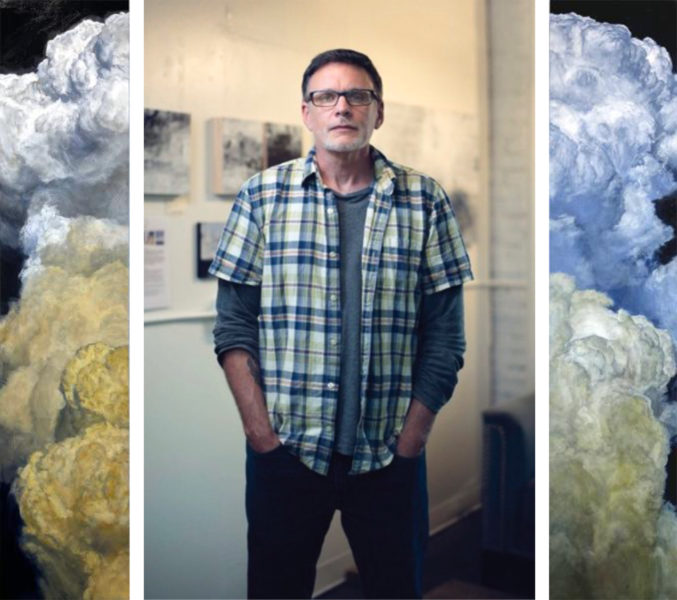
New Gallery MAR artist Peter Roux with his works “Liminal No. 1” (left) and “Liminal No. 2” (right)
Asheville based artist Peter Roux works within languages of light and imagery, exploring the push-pull of abstraction and landscape in his work. While many of his paintings may be recognizable in nature — a sky full of clouds or a vast meadow landscape, for instance — his works focus more on the experience of space rather than the space itself. One of his most iconic series, his cloud series, captivates viewers with its billowing shapes and dynamic compositions of layered light. These paintings, though seemingly straightforward in subject, contain within them complex multitudes: the push-pull of light and dark, of foreboding and hopefulness, of chaos and romance, and of simplicity and grandeur.
Perhaps you admire the work of Peter Roux for all of this paradoxical complexity, or perhaps you admire it because it is, quite simply, breathtakingly beautiful. Artist Peter Roux wants you to know that no interpretation of his work is incorrect. The inescapable draw of his work may just lie in the vast multiplicity of interpretations it elicits, so we implore you to go ahead and tap into that universal desire to stare into the clouds and dream of the possibilities.
However you may interpret his work, we hope you will join us in welcoming artist Peter Roux to Gallery MAR. Please enjoy this our first conversation with the artist from his studio in Asheville, North Carolina.
How did you first know that you wanted to make art your profession?
I’m really one of those people who cannot remember wanting to do anything else. I grew up in a military family, and we moved around a lot, so I spent a lot of my time kind of alone. I think I was really pulled towards drawing as a way of spending my time and relating to the world around me. It was kind of a solitary activity, but I think that was appealing to me. I wasn’t sure exactly what I was interested in doing, but I knew that it was going to involve art in some way.
There was a time when I thought about becoming an architect. Then as I got older, I remember thinking that the most practical move would be going into illustration. I quickly transitioned to fine art mainly because I knew that that was where I was going to be happiest.
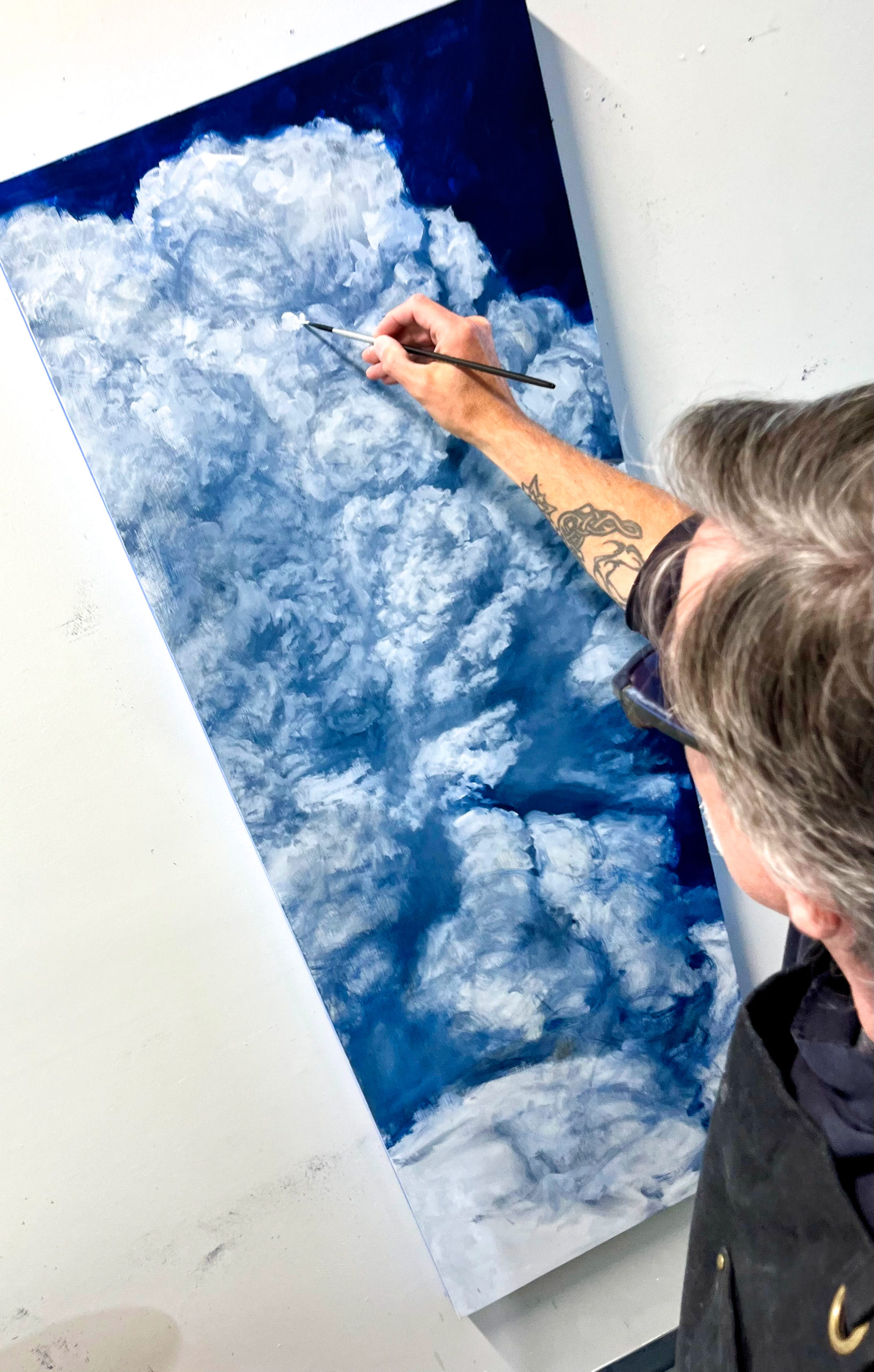
Peter Roux adding layers of light to his cloud paintings in his studio
How did you discover oil painting in particular as your primary media?
I went to a small progressive high school and one of the teachers was an artist. They were very supportive. I had only done watercolors before that, but that teacher introduced me to oils. I think I really responded to it because of its depth and its luminosity. I think that the barriers that using oil paint present to people are the same things that I really responded well to: the blending, the time, the chemistry involved.
I work mainly in oils but I also do a lot of drying charcoal. I also do printing types. I especially like mono types because they have such a painterly feel to them. I like the immediacy and the risk of those printmaking techniques.
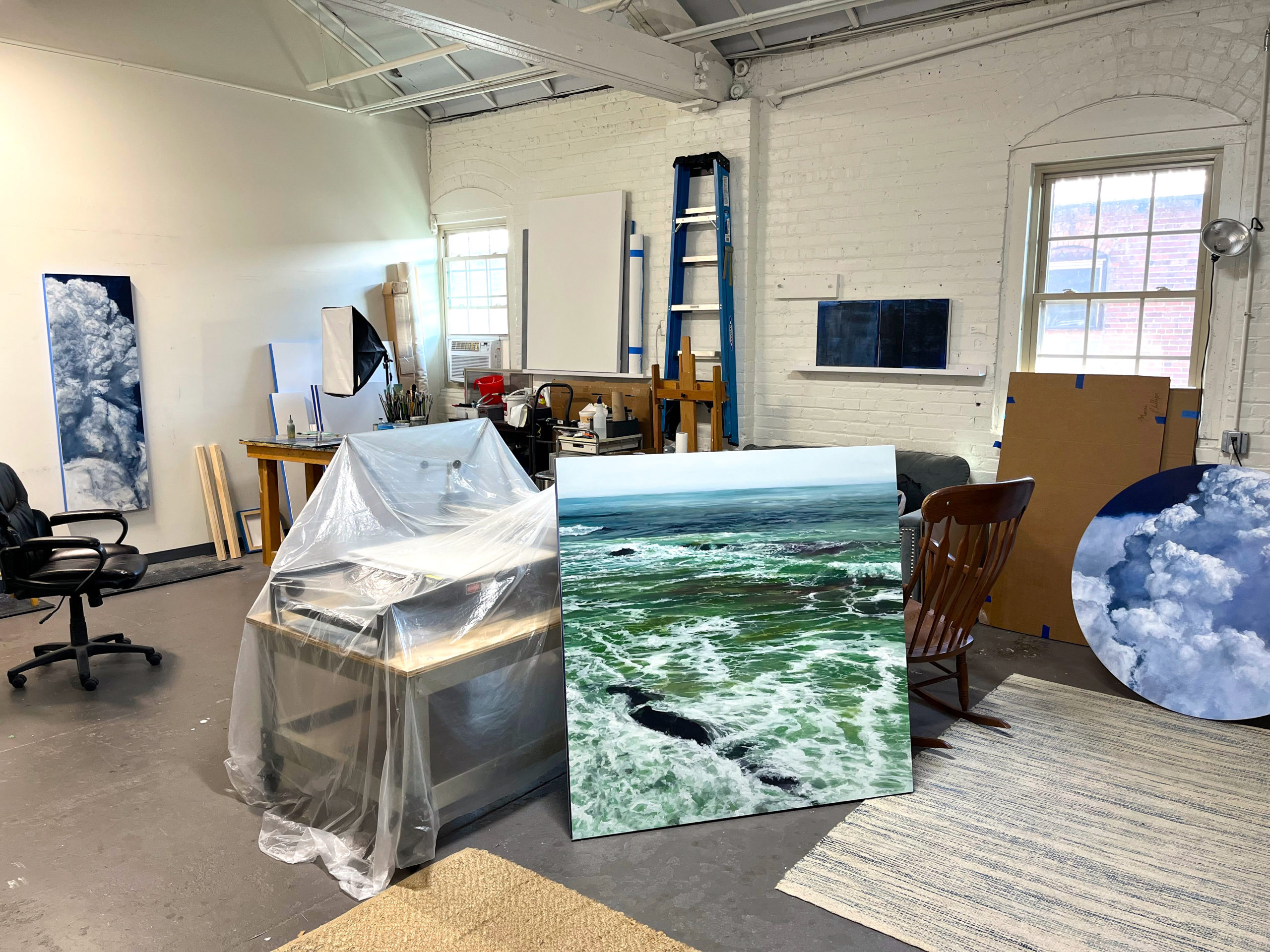
A snapshot of Peter Roux’s studio in the River Arts District in Asheville, NC
Could you walk us briefly through your process?
I work on wood panels as well as stretched canvas. I’ve worked en plein air before, but I typically work from reference photos. Sometimes I will cobble a few together and work a compositional structure from one and a color palette from another and blend them together.
In terms of the process, I’m really sort of building. I think of oil painting as a language of light, and I’m always working towards that light. I always have that idea in my head as I’m building subject, space, and relationships.
“I think of oil painting as a language of light, and I’m always working towards that light.”
– Peter Roux
I also think a lot about edges and edge quality. Edges are where relationships sort of come together: the edges in the cloud series, and the clouds themselves, and how they move together. They are really critical to me in terms of understanding them and exploring them. I think the same thing holds true for any subject that I approach. I’m always thinking of working towards the light, pushing light over dark, pushing light into dark, and getting that sense of volume and that sense of presence.
I consider myself primarily a landscape painter, although I do work in pure abstraction as well, and I always have. I found that I also like to push the two languages together in my work sometimes. I use one to sort of disrupt and interrupt the other. I like combining those two languages a lot.

Peter Roux, “Suspension,” oil, 30″ x 72″
You briefly mentioned using photographs as a reference for your work. In your artist statement, you write, “We take in physical space differently than those who lived before us. Photography, film, the frequency of imagery- these daily intakes help define how we see the world around us. It’s what we see, and how we see.” Could you elaborate on how this intake of images affects how we now see the world?
Well I’ve described myself before as sort of a frustrated filmmaker. I grew up in that language of filmmaking: of tv and of a culture where imagery was prevalent. I love using the language of film, but really what I love is the language of imagery. While I call myself a painter, I think of myself more as someone who makes images. Paint happens to be a really, really good tool for me to explore that through.
I believe strongly that the medium always plays a role in the creation of an image and I always want to think about that and honor that when I paint, but also at the end of the day, I’m interested in how we take images in.
“While I call myself a painter, I think of myself more as someone who makes images. Paint happens to be a really, really good tool for me to explore that through.”
– Peter Roux
I remember when I was a little kid looking out the window while my parents were driving and seeing everything blurring past me. I remember thinking how interesting all of that was: the striations and the motion and the design and the light and all of that. I just found that so fascinating. I think about that a lot and about the fact that if I were born a couple of hundred years ago, I would never know that experience. We didn’t have the technology to move through space in that same way, so our relationship to the space around us is different.
People are now exposed to images over and over and over again each day. That has to inform how we see the world and how we understand the world. What that means to me is that the culture of imagery in which we live and have lived for decades has played a role in how we understand reality and how we understand the world…and I don’t mean that critically – I mean that as a fact.
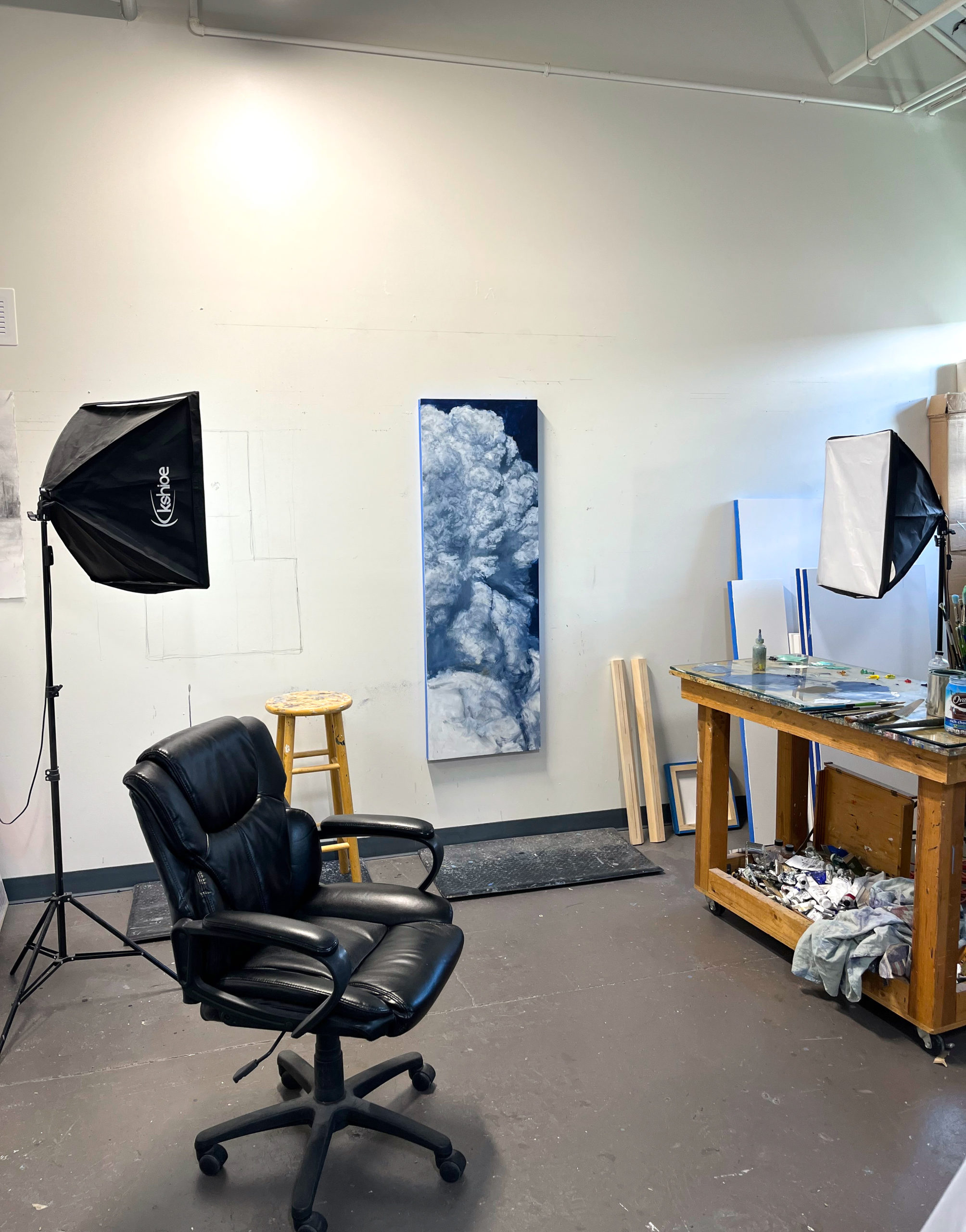
Art photography underway in Peter Roux’s studio
That’s interesting! You really do talk about your work like a filmmaker. What role does film play in your work or what influence does it have?
I grew up with movies. I love the language of film, but it’s not just the film itself, it’s not just the idea of projected light reflected onto a screen. I’m talking about how letterboxing has become so familiar to us. On television and in movies, there are these black bars that are cutting into sections of the image and they fall away from us. We’re subject to editing what we see and experience, and I love that idea. Editing can play such a role because we’re not just looking at images of something, we’re looking at a representation of something that has gone through someone else’s process. In some of my work, I started bringing in these black sections, these black bars. I’m exploring that language of letterboxing and compressing imagery to fit on the screen. I was always fascinated by that when I would watch movies as a kid. For some reason that was always very intriguing to me.
Wow — you were quite a thoughtful, introspective kid. I don’t know many children who would look at the black letterboxing rather than the movie. Please correct me if I’m mischaracterizing, but it sounds like you’re more interested in capturing the experience of space rather than the space itself.
Exactly! Sometimes I get caught up in form as much as I do in content.
The experience in space is really what changes over time, and it’s different than it was in the past. That’s a real interest to me.
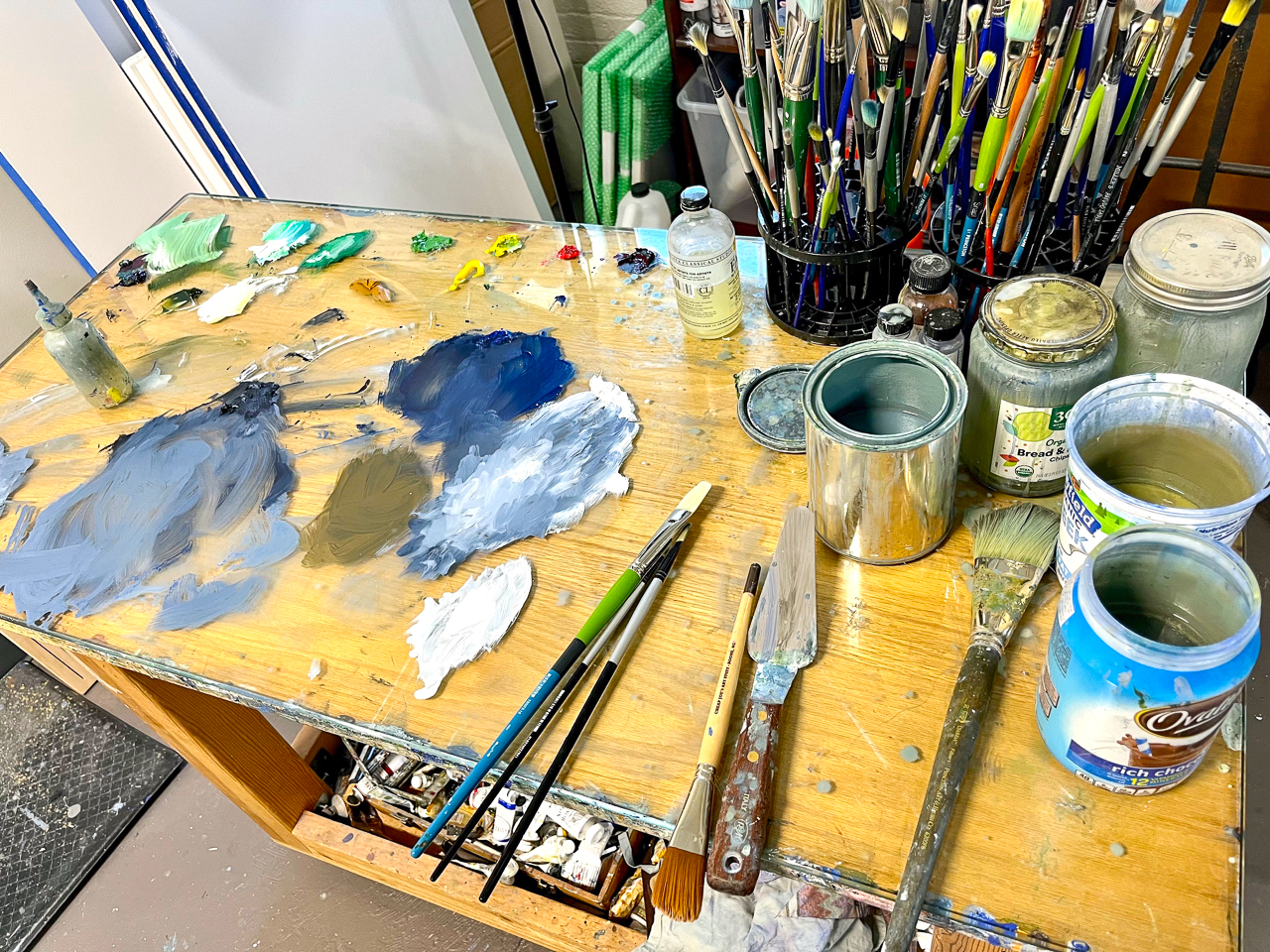
Peter Roux’s palette and brush setup in his Asheville studio
Could you tell us more about your subject matter, especially your new cloud series? How did you discover clouds as a subject and what interests you about them?
I tend to be drawn to landscapes that are not too specific but are, instead, areas that have a bit of simplicity and a bit of vagueness. I’m less interested in capturing identifiable, specific spaces as I am in creating a space that jogs a memory, that we can jump from.
The subjects tend to be a bit simpler with the exception of the clouds, which I’ve been doing for about 7-8 years now. It’s funny – if you had told me back then I’d be painting clouds, I would have thought that you were crazy. I used to think of clouds as a subject I would never touch, because I found them to be so romantically loaded and epic that I thought that, if anything, I would be trying to push against that. The same is true for large mountain ranges. I was apprehensive about pushing against that grandeur, so I was never really drawn to it. Finally one day, I stopped looking straight across at the landscape, and I looked up for a second. I saw the clouds’ edges, and I thought, “well that looks really challenging, doesn’t it?” I was intrigued by the idea of playing around with those edges and seeing if i could do it in a way that wouldn’t be overly romantic and see what happens.
“There are very few subjects that are more universally connecting than clouds. No matter what the landscape, whatever part of the world you inhabit, you look up and there is a connecting subject experience above you”
– Peter Roux
So I started painting the cloud series. Out of all of the series of subjects that I’ve painted in my career, never has there been more dissonance between what people tend to see and describe that they see in my work and what I see in my work. That’s really interesting to me. People will sometimes look at the clouds and say words like “epic” and “romantic” and “calming,” and I don’t find them to be any of those things. I find them to be chaotic, and complex, and sometimes even foreboding. They are a subject that refuses to stand still and the refusal is almost inherent in the form itself, and I like that.
There are very few subjects that are more universally connecting than clouds. No matter what the landscape, whatever part of the world you inhabit, you look up and there is a connecting subject experience going on up there, with very few exceptions. I saw that as an interesting entry point for people into the work. People are drawn to the clouds, and I think that’s because we share that common experience with them everyday. I could say “those cloud paintings have nothing to do with clouds,” but it doesn’t really matter. Everybody’s experience is going to be whatever they bring to it and whatever is intensely familiar to them that they’ve known since their earliest memories. I still sometimes struggle with pushing against the romance of it, but I don’t want to control people’s experience of the work.

Peter Roux, “Liminal No. 1,” oil, 46″ x 10″ | Peter Roux, “Liminal No. 2,” oil, 46″ x 10″
I notice many of your works are uniquely shaped – whether they’re on round canvas or long rectangles. Could you talk a little about this and why you’re drawn to these unique shapes?
When I’m thinking about the language of imagery, I’m thinking about all kinds of things. Mostly about the edges of them. I think about images and paintings as windows and that has historically really driven why paintings are in square and rectangular formats. There’s this idea of creating a window that creates another space inside of it. I love photographers like Sally Mann because the physical nature of the process is very apparent. I like the physicality of paintings and images in the same way.
If I think about every painting as a window, I think about the shape of that window as much as anything else. I started playing with the idea of challenging myself with a unique structure. I love the challenge of trying to create this spatial statement inside what I was restricting myself to. It’s all about setting up new challenges and seeing what happens.
Written and interviewed by Veronica Vale
 Studio Stories: America Martin
Studio Stories: America Martin Gallery MAR Holiday Gift Guide 2025
Gallery MAR Holiday Gift Guide 2025 The Art of People - Capturing Sonder
The Art of People - Capturing Sonder